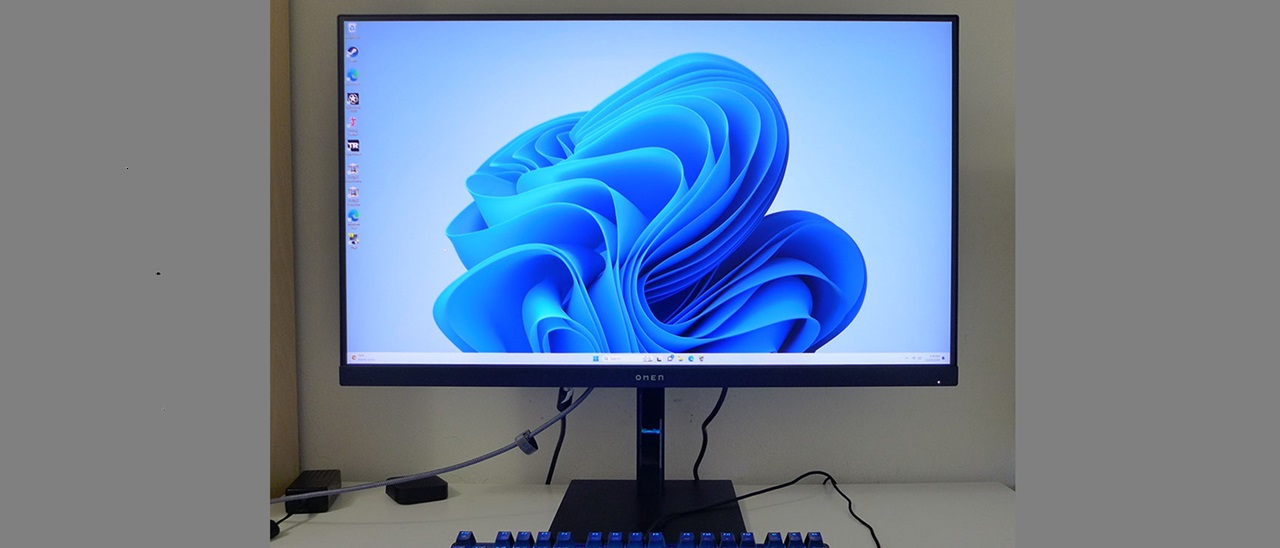Tom's Hardware Verdict
The HP Omen 32q delivers big-screen gaming with a bright and colorful image, premium video processing and a surprisingly low price. You’ll be hard pressed to find a better 32-inch monitor for less than twice the money.
Pros
- +
Bright and colorful image
- +
Excellent out-of-box color accuracy
- +
Best-in-class HDR
- +
Premium video processing
- +
Rugged build quality
Cons
- -
Below average native contrast
Why you can trust Tom's Hardware
Speed is what transforms a display into a gaming monitor. 144 Hz is the general starting point, and it only gets faster from there. But size and shape are also important. A fast panel must also immerse the player in the virtual environment; the best way to do that is with a jumbo screen. Ultra-wides are cool, but they don’t offer the height of a 16:9 aspect ratio. 32 inches is the way to go if you want a traditional shape among the best gaming monitors.
Once in the realm of the exotic and expensive, 32-inch monitors are much more affordable today. HP’s Omen series of gaming monitors offers terrific value and high performance, and I have one of the finest examples yet, the Omen 32q. It’s a 32-inch QHD IPS panel with 165 Hz, Adaptive-Sync, HDR 400, wide gamut color and a price of just $400 at this writing. Let’s take a look.
HP Omen 32q Specs
| Panel Type / Backlight | IPS / W-LED, edge array |
| Screen Size Aspect / Ratio | 32 inches / 16:9 |
| Max Resolution and Refresh Rate | 2560x1440 @ 165 Hz |
| Row 3 - Cell 0 | FreeSync: 48-165 Hz |
| Row 4 - Cell 0 | G-Sync Compatible |
| Native Color Depth and Gamut | 8-bit / DCI-P3 |
| Row 6 - Cell 0 | HDR10, DisplayHDR 400 |
| Response Time (GTG) | 5ms |
| Brightness (mfr) | 400 nits |
| Contrast (mfr) | 1,000:1 |
| Speakers | None |
| Video Inputs | 1x DisplayPort 1.4 |
| Row 12 - Cell 0 | 2x HDMI 2.0 |
| Audio | 3.5mm headphone output |
| USB | None |
| Power Consumption | 26.8w, brightness @ 200 nits |
| Panel Dimensions WxHxD w/base | 28.1 x 20.4-24.4 x 9.6 inches (714 x 518-618 x 244mm) |
| Panel Thickness | 2.1 inches (53mm) |
| Bezel Width | Top/sides: 0.3 inch (8mm) |
| Row 19 - Cell 0 | Bottom: 0.9 inch (23mm) |
| Weight | 19.8 pounds (9kg) |
| Warranty | 3 years |
Where competitors use VA panels, the Omen 32q is based on an IPS part. This means high brightness, over 400 nits in my tests, and plenty of color. Contrast is average at around 800:1, but that is the only weakness I found. Color is incredibly accurate for both SDR/sRGB and HDR/DCI-P3. In other words, it’s reference level after a few adjustments. HDR is also enhanced by dynamic contrast, which broadens the ratio to over 10,000:1 and renders a peak just shy of 500 nits.
With a 165 Hz refresh rate, frame rates are adequate for all but the most skilled gamers. HP’s premium video processing is included with one of the best overdrives out there and a fully usable backlight strobe that runs instead of Adaptive-Sync if that’s your preference. The Omen 32q flawlessly supported G-Sync in my tests but has not yet been certified by Nvidia. It also runs FreeSync over a 48-165 Hz range.
Build quality and features are better than you’d expect for the price. The panel and stand have plenty of heft and look ready for long-term use. Gaming aids include aiming points, frame counter, timers and alignment marks. What’s missing? USB ports, internal speakers and LED lighting are not necessary for good gaming. Plug headphones into the 3.5mm jack and you’ll have better sound than any built-in speakers can boast.
The Omen 32q is the fourth new HP Omen monitor I’ve looked at of late and I continue to be impressed by what you get for the money. They are serious displays, for serious players.
Assembly and Accessories
HP delivers the Omen 32q in a clamshell box with molded pulp instead of crumbly foam to protect the contents. The only plastic is a few sheets of Teflon; everything else is fully recyclable. The stand and base mate with a captive bolt, and then the panel snaps on. A cover goes on to hide the mounting hardware. Or you can use an arm with the 100mm VESA mount and its included fasteners. An IEC power cord feeds the internal supply, and you get a thick DisplayPort cable, which should have no problem running high-bandwidth signals.
Get Tom's Hardware's best news and in-depth reviews, straight to your inbox.
Product 360


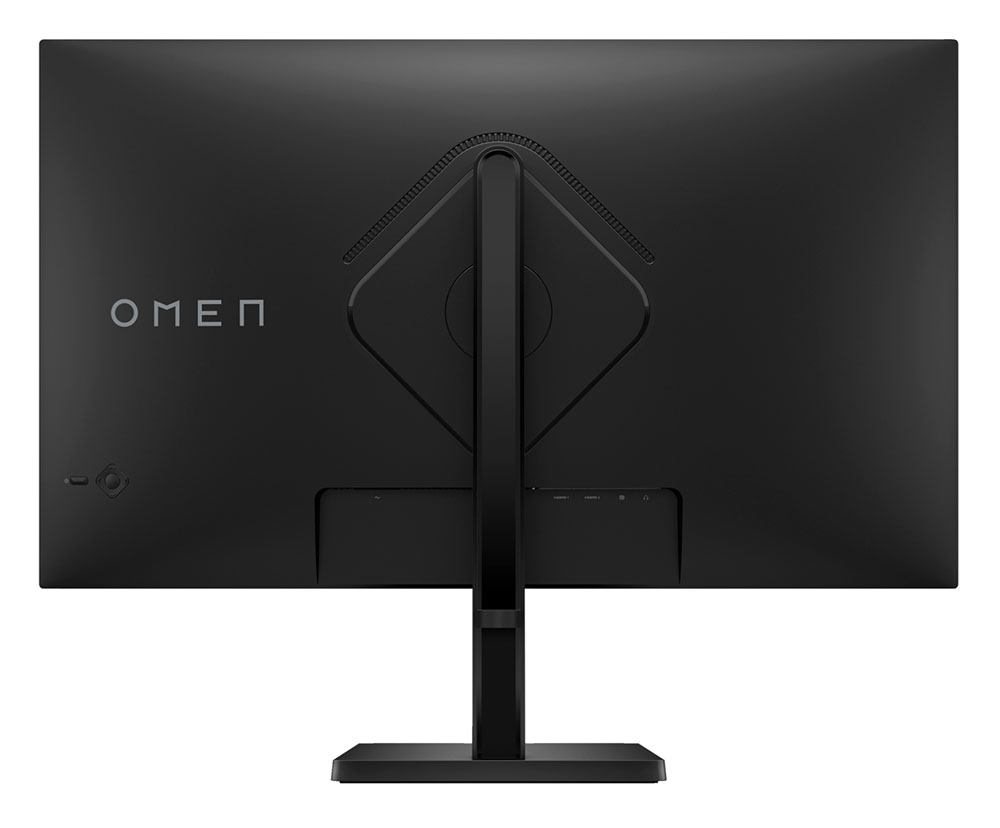
You’ll know it’s an HP Omen by the printed logo on the front, but any other styling cues are subtle. The Omen 32q could easily blend in with enterprise screens, but that’s not a bad thing. If you don’t like the look-at-me aesthetic, this monitor is for you. A larger Omen logo appears around the back, but that’s the extent of it. Corners are slightly rounded, and surfaces are smoothly tapered. Only a diamond shape, HP’s symbolic trademark, appears on the base and around the stand’s attachment point. The tiny white power LED is also a diamond; you can tell if you look closely.
The stand is rock solid, though the base seems a tad small for a panel this large. It’s a bit top-heavy, but it's stable enough unless you have rambunctious children frequenting your office. Like the other Omens I’ve reviewed, there is no traditional swivel adjustment, but the base has rubber and felt feet that allow it to pivot about a single axis, so you can quickly turn the whole thing from side to side. You also get a four-inch height adjustment with 5/20-degree tilt and a 90-degree portrait mode.
The Omen 32q’s functions are controlled with a small set of buttons arranged in a nav pad shape. It works like a joystick and is very intuitive. A separate button toggles power. The input panel is up and under the center of the panel and includes one DisplayPort 1.4 and two HDMI 2.0 ports. There is no USB, but you get a 3.5mm audio jack for headphones or powered speakers.
OSD Features
Pressing any of the Omen 32q’s buttons reveals a quick menu that the user can configure. The select key opens the full OSD. It announces the model name at the top left and shows signal information at the bottom, along with the active input.
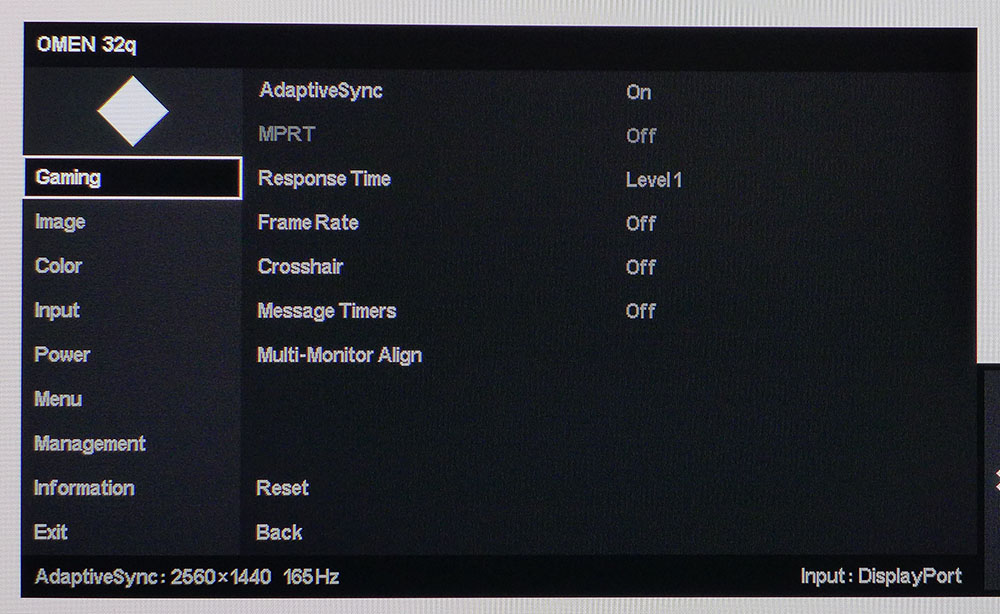
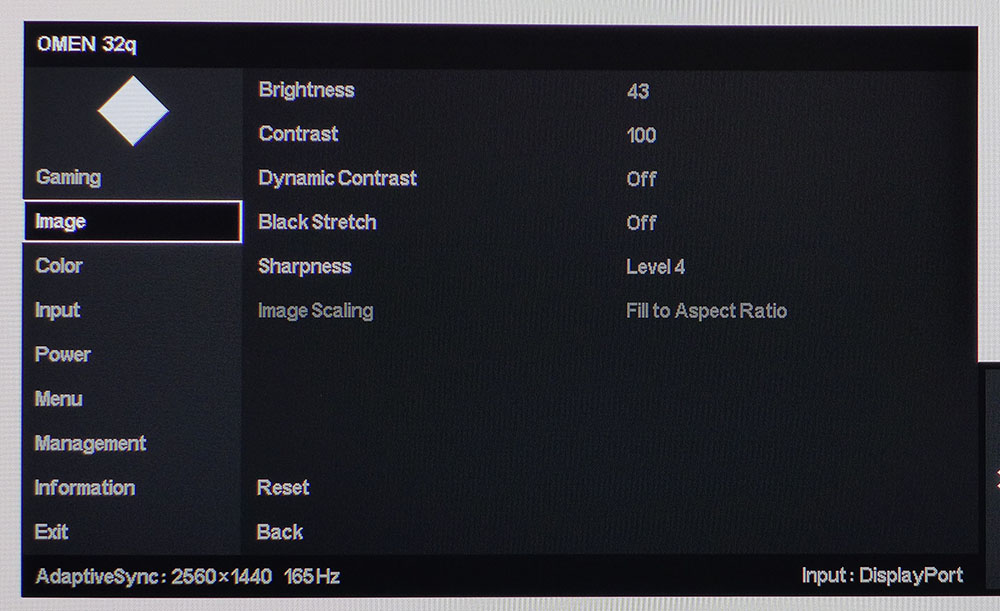
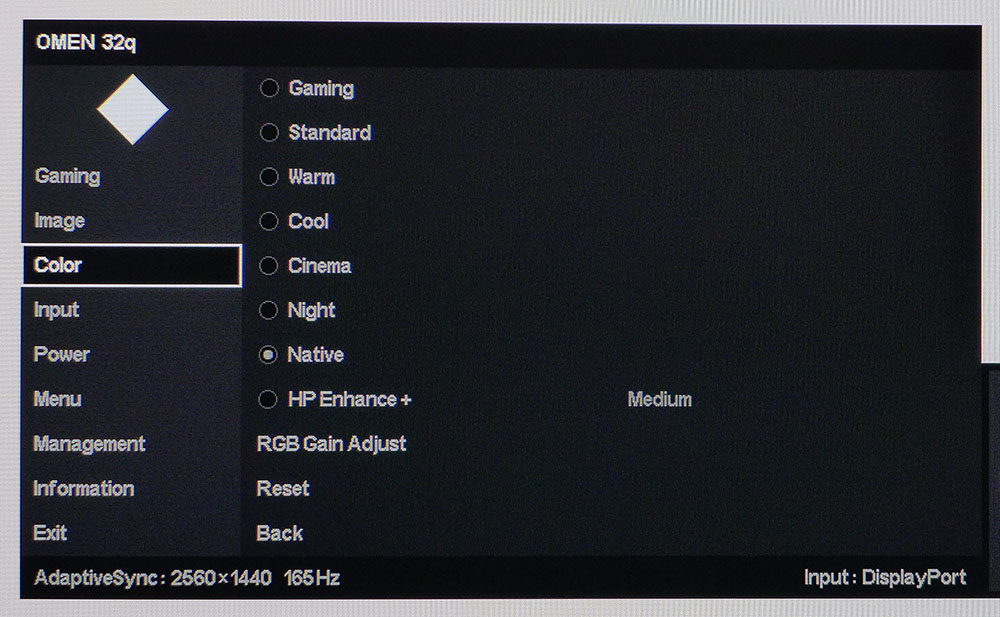
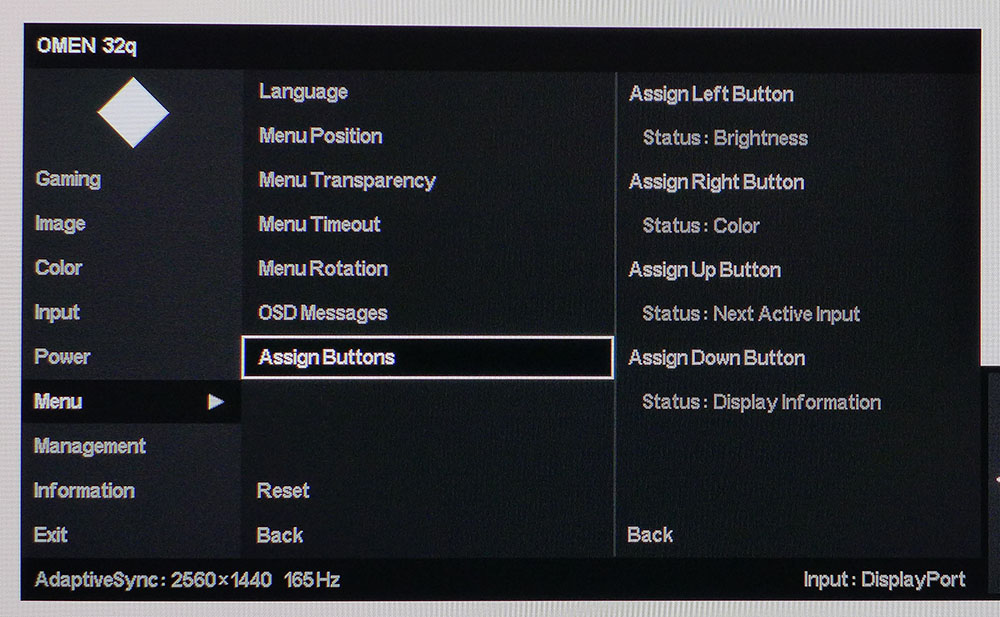
The gaming menu has an Adaptive-Sync toggle and five levels of MPRT, the backlight strobe. Higher settings reduce blur and light output in tandem. I was able to play at number three with no apparent phasing artifacts. HP is one of the few companies to implement this feature successfully. At 165 Hz, you’ll see the occasional frame tear, so I stuck with Adaptive-Sync and the superb overdrive, which works up to level four of five without trail artifacts. You can also turn on aiming points, timers and an fps counter here.
For SDR content, the Omen 32q includes dynamic contrast, which increases the ratio to around 5,000:1. Black Stretch makes shadow detail more visible at the expense of black levels.
The Omen 32q has eight picture modes, all of which are independently adjustable. Once you select a mode, scroll down to RGB Gain Adjust to dial in the white balance. Standard is the default and runs sRGB color with SDR content. It doesn’t need calibration. If you want the wide gamut for SDR, Native provides that, but you’ll need to make some tweaks. I’ll tell you how below. In the Menu menu, you can assign the four directional buttons to different functions like brightness, input, color mode or signal information.
HP Omen 32q Calibration Settings
The Omen 32q works fine right out of the box in its Standard mode with no visible color, grayscale or gamma errors. SDR signals will use sRGB and HDR uses the full DCI-P3 gamut. I made a tiny improvement to Standard by tweaking the RGB sliders. There is no gamma adjustment, but it sticks close to the 2.2 reference. If you want the wide gamut for SDR, choose Native. It requires more tweaking as its grayscale is visibly blue in tone. With calibration, it, too, has no visible errors. I observed that brightness is a little higher in Native mode, so you’ll need different settings for a given output level. I’ve provided my values for Standard and Native below.
When HDR signals are present, the Omen 32q switches automatically, and all picture controls are grayed out. Dynamic contrast is locked on, and you’ll see the ratio jump to around 10,000:1. I also observed very accurate color there.
| Picture Mode | Standard / Native |
| Brightness 200 nits | 61 / 43 |
| Brightness 120 nits | 35 / 21 |
| Brightness 100 nits | 26 / 16 |
| Brightness 80 nits | 17 / 11 |
| Brightness 50 nits | 5 / 3 (min. 42 nits) |
| Contrast | 100 |
| Color Temp User | Standard – Red 255, Green 255, Blue 253 |
| Row 8 - Cell 0 | Native – Red 255, Green 242, Blue 228 |
Gaming and Hands-on
Right from the start, the Omen 32q proved to be a competent gaming monitor that performed well above its price point. I usually say that fast monitors spoil me as I have played on many 240, 360 and 500 Hz screens. 165 Hz, in most cases, is clearly softer in the motion resolution department. But the Omen 32q’s overdrive is so good I could have easily been fooled into thinking it was running at 240 Hz. At level 4, no trail artifacts were visible and motion blur was so minimal that I had to look hard to see it.
Input lag wasn’t a factor either. I noticed no delay or stutter at any time. My test PC’s GeForce RTX 4090 had no problem keeping frame rates at 165fps, so for me, it was an ideal scenario. I was able to use the Omen 32q at its full potential. Trying out the MPRT backlight strobe proved illuminating, as it operated without visible artifacts. I saw a few frame tears, but they weren’t frequent. This is one of the few monitors that manages this feature without visible phasing. It is a viable option for gamers who prefer it to Adaptive-Sync.
Playing SDR games like Tomb Raider, I found contrast to be lacking. I could mostly compensate by turning on dynamic contrast in the OSD, but without that enhancement, blacks were more a dark gray and the picture lacked verve.
Playing in HDR mode was a completely opposite experience. The Omen 32q, like other recent Omen screens, delivers superb HDR. While it won’t produce the drama of a 1,000-nit Mini LED screen, it comes closer than you’d think. The HDR image is superb, with around 500 nits peak output and dynamic contrast around 10,000:1. Its color is also vibrant, with brilliant primary hues and natural-looking earth tones. Metallic surfaces and objects had a tactility that really impressed me.
Though the Omen 32q’s pixel density sounds low at 93ppi, I didn’t notice the pixel structure during gameplay. Distant details resolved sharply, and foreground objects had a satisfying sense of dimension. Though the default for SDR content is sRGB color, I was drawn to the Native picture mode and its use of the full DCI-P3 gamut. That extra saturation helped hide any hint of pixelation.
For productivity, the Omen 32q is well suited for bread-and-butter business apps like Word or Excel. For graphics work though, I’d want a higher resolution. QHD in the 32-inch size is a little soft for fine detail in Photoshop, but it’s fine for basic graphics. If you want to watch video, just sit back about four feet, and you’ll enjoy an immersive experience.
The Omen 32q’s size is what makes it attractive. I’ve played and worked with many ultra-wides at some extreme dimensions, but my favorite screen is a 32-inch 16:9. It’s my everyday monitor because it functions equally well as a workday tool or a gaming screen. It has a significant height advantage over 21:9 monitors, immersing me more than prodigious width. Of course, your mileage may vary.
Takeaway: The Omen 32q delivers gaming performance and image quality well above its $400 price tag. Video processing equals the best premium screens I’ve reviewed, and the image is colorful and accurate. The gaming experience is smooth and effortless, while the jumbo panel provides a highly immersive quality. It’s hard to imagine a better jumbo gaming monitor for the money.
MORE: Best Gaming Monitors
MORE: How We Test PC Monitors
MORE: How to Buy a PC Monitor
MORE: How to Choose the Best HDR Monitor
Current page: Features and Specifications
Next Page Response, Input Lag, Viewing Angles and Uniformity
Christian Eberle is a Contributing Editor for Tom's Hardware US. He's a veteran reviewer of A/V equipment, specializing in monitors. Christian began his obsession with tech when he built his first PC in 1991, a 286 running DOS 3.0 at a blazing 12MHz. In 2006, he undertook training from the Imaging Science Foundation in video calibration and testing and thus started a passion for precise imaging that persists to this day. He is also a professional musician with a degree from the New England Conservatory as a classical bassoonist which he used to good effect as a performer with the West Point Army Band from 1987 to 2013. He enjoys watching movies and listening to high-end audio in his custom-built home theater and can be seen riding trails near his home on a race-ready ICE VTX recumbent trike. Christian enjoys the endless summer in Florida where he lives with his wife and Chihuahua and plays with orchestras around the state.
-
mwm2010 I have an HP Omen 27Q, and I wasn't at all surprised to see that this monitor is basically the same as mine, but with gsync and 32 inches. Still super impressed though.Reply -
idrisdroid why the hdr contrast is mesured this high?Reply
i have an issue with this, since you don't explain what was used to achieve this. i have an idée, it is dynamic back lighting, what it mean that you will never see dark image with high ligt in the image. and never a dark earia when the rest of the image is bright
this is very important to ,notice
